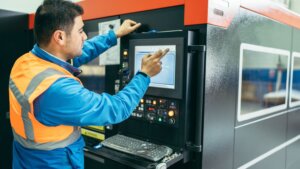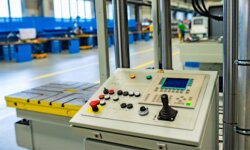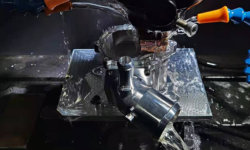Machining operations run most of the manufacturing processes worldwide. They either create the final product completely or make the tools needed for manufacturing. Therefore, understanding machining processes is key to the skillful execution of your next manufacturing project.
This article will discuss in detail the various types of machining operations. You can choose the right fit for your requirements based on the information provided here.
What is Machining?
Machining is a manufacturing process that removes material in a controlled manner to produce the required part. Therefore, machining is also known as a subtractive manufacturing process. The workpiece is always bigger than the required part. Machining processes have a higher precision than alternatives like additive manufacturing techniques.
What are the Different Types of Machining Operations?
Machining operations have many different types to suit various requirements. These different types of machining processes are:
Conventional Machining Process
Conventional machining processes are the traditional machining processes. These processes use physical tools like cutting blades and drill bits to accomplish the machining action. The different types of conventional machining processes are:
Turning
In turning, a workpiece rotates around a central axis. The cutting tool is stationary and removes symmetrically from the workpiece’s surface. Turning operations are generally performed on cylindrical and conical shaped objects. The workpiece can be hollow or solid. Some applications of the turning process are:
- Engine parts
- Machine parts
- Shafts
- Holes
- Grooves
- Threads
- Taper
Drilling
Drilling is used to make holes in a workpiece. The holes are used for screws or aesthetic purposes. Drilling operations are the most common type of machining process. Drilling is carried out on a drill press. Drill presses can be manual, or CNC machine mounted. The cutting tool is called a drill bit. Applications of drill press are:
- Making screw holes
- Making threads
- Holes for aesthetic appeal
Boring
The boring operation is used to enlarge a pre-drilled hole. The enlargement is done with a single-point cutting tool. Initially, a small hole is drilled with the help of a drill press or any other alternative. Boring tools can be mounted on lathes, milling machines, and drill presses. Applications of boring are:
- Engine shafts
- Gun cylinders
- Turbine cylinders
Reaming
Reaming is used to enhance the quality and precision of holes. Reaming operations are used for the secondary finishing of workpiece holes. It can make the hole diameter more accurate, round, and with a smooth surface finish. Reaming utilizes multi-point cutting tools. Reaming machine is called a reamer. The reaming process follows holes created by drilling or boring. Applications of reaming are:
- Aircraft components
- Engine parts
- Fuselage
- Landing gear
Milling
The milling process utilizes a high-speed rotary cutting tool against a stationary workpiece. It works on an automated or manual milling machine. The cutting tools in milling machines have various shape options. Based on the variation of cutting tools, there are many different types of milling operations. Common examples are end milling machine, face milling machine, knee milling, etc. Applications of milling machines are:
- Slotting
- Contours
- Gear cutting
- Thread making
Grinding
Grinding is a secondary finishing process for improving the surface finish. It uses an abrasive rotary disc called a grinding wheel. Grinding processes can smooth the defects caused on a workpiece due to other machining processes. Surface grinders can also improve the dimensional accuracy of a workpiece. Application of the grinding machining process are:
- Surface finishing
- Descaling
- Deburring
- Precision Machining
Tapping
Tapping cutting tool is used to make internal threads on the work material. The cutting tool itself is called the tap. Tap can have a cylindrical or conical shape. The tap rotates and moves inside the workpiece linearly. This results in the thread formation on the internal periphery of the workpiece. Holes are pre-drilled on the workpiece with drilling or boring. Application of tapping are:
- Threads for screws and bolts
- Plumbing
- Part assembly
Planing
Planing is used for machining a complete surface in a single pass. Planing machines can smoothen an entire surface of a workpiece. It can also create inclined surfaces. Planar cuts can also create niche features on surfaces. Applications of planing are:
- Woodworking
- Dovetail joints
- Slots and groove making
- Creating accurate flat surfaces
Knurling
Knurling is a surface finishing process. It creates a pattern on the workpiece surface. The pattern can be vertical lines, horizontal lines, or criss-cross grids. Knurling can be done for aesthetic reasons and practical purposes. It utilizes a knurling pin rolled against the workpiece surface. Applications of knurling are:
- Making hand grips of tools such as hammer
- Aesthetic Appeal
Sawing
Sawing uses a cutting tool for slicing through the workpiece. The cutting tool can be abrasive or have toothed bands on the blade. Sawing is used to divide a workpiece into small parts. It is not as accurate as other machining processes. Applications of sawing are:
- Woodworking
- Dies
- Metal fabrication
Shaping
Shaping machine is a fast way of altering the basic shape of a workpiece. It uses the reciprocating mechanism between the cutting tool and the workpiece. The workpiece moves back and forth against the cutting tool. Shaping can generate flat surfaces, inclines, and even curved surfaces. Applications of shaping are:
- Making internal spline holes
- Making flat surfaces
- Gear teeth
- Dovetail joints
- Keyways
Broaching
Broaching uses a toothed cutting tool to remove material from a workpiece. The tool used in broaching is called a broach. Broach takes a minimal amount of material from a workpiece in a single pass. It is applied for making niche features in a workpiece. Broaching commonly makes parts like:
- Keyholes
- Splines
- Gears
- Slots
Lapping
Lapping process is used for secondary finishing operations on a workpiece. In lapping, the workpiece surface rubs against the lap plate. There is an abrasive paste or powder placed between the two surfaces. Lapping averages the rough features of the workpiece surfaces, leading to smooth edges. Application of lapping is:
- Creating truly flat surfaces with high accuracy
Non-conventional Machining Process
Non conventional machining process does not use traditional cutting tools. Instead, these machining techniques utilize heat or force for material erosion. Non conventional machining processes are more modern with high precision. Let us go through these various types of machining operations:
Electrical Discharge Machining (EDM)
EDM uses electrical pulses of high voltage frequency for cutting the workpiece. The pulses generate electrical arcs that melt the material at the required location. This results in a highly precise cut. This method applies to cutting conductive materials only. Applications of electrical discharge machining are:
- Mold manufacturing
- Die manufacturing
- Blanking punches
- Tooling
- Surgical equipment
Chemical Machining
Chemical machining uses chemical reactions to remove material from the workpiece. This process is also called Etching. The material removal occurs by dipping the workpiece in a chemical agent. The workpiece is masked, and the areas to be removed are left unmasked. This process can create thorough cuts as well as engraving. Applications of chemical machining process are:
- Machining highly thin parts
- Automobile parts
- Aircraft parts
- Fine screens
- Wire meshes
- Machining hard-to-handle workpiece
Electrochemical Machining (ECM)
Electro chemical machining combines the chemical machining process with electrical energy. This process is the opposite of electroplating. This process is independent of surface hardness and machinability. Therefore, it can be used to machine hard materials with ease. It is also good for machining materials with poor machinability. Applications for ECM are:
- Drilling multiple holes
- Die sinking
- Profiling
- Contouring
- Turbine blades
Abrasive Jet Machining
Abrasive jet machining uses abrasive particles to remove material from the workpiece. A high-speed stream of gas provides energy to the abrasive. Abrasive jet machining is known by many other names like pencil blasting, abrasive micro blasting, and micro-abrasive blasting. The applications of Abrasive Jet Machining are:
- Cutting heat-sensitive materials
- Deflashing
- Work surface cleaning
- Deburring
- Glass frosting
Ultrasonic Machining
Ultrasonic machining uses a high-frequency vibrating tool to remove workpiece material. There is the presence of abrasive material between the tool and the workpiece. The abrasive material is mixed with water to create a fine abrasive paste. The tool vibrating at high frequency uses the abrasive paste on the tip to remove the material. Applications of ultrasonic machining are:
- Machining sensitive materials
- Glass Cutting
- Optical equipment
- Electrical equipment
Laser Beam Machining (LBM)
Laser beam machining uses high energy light beam to melt and remove the workpiece material. LBM machining operations can work on all types of materials. These types of machining operations are usually applied on materials with poor conductivity because of the limitations of EDM and other electrical methods. Applications of LBM machining operations are:
- Cladding
- Surface Treatment
- Marking
- Medical equipment
- Marine industry
- Automobile sector
- Aircraft industry
Water Jet Machining
Waterjet machining is a cold-cutting process. It uses the force of high-pressure water with a very narrow stream. The water stream can pierce through hard materials as well as softer materials with ease. Abrasive particles are often added to the water to speed up the cutting process. Applications of water jet machining are:
- Surgical equipment
- Automotive parts
- Dental implants
- Prototyping
- R&D
Ion Beam Machining (IBM)
Ion Beam Machining is a surface finishing process. It alters the structure of the workpiece on a molecular level. Ions are accelerated and made to collide with the workpiece. The high velocity ions alter the material molecules on the workpiece surface. Applications of Ion Beam Machining process are:
- Etching in the electronics industry
- Optical industry
- Fine wire die
Plasma Arc Machining (PAM)
Plasma arc machining uses a high-velocity ionized gas. The ionized gas creates a plasma arc that melts the workpiece at the desired location. The high-speed stream of air blows away the melted material. This results in a clean and highly precise cut. Applications of Plasma Arc Machining operations are:
- Cutting stainless steel alloys
- Profile cutting of metals
- Handling hard-to-machine materials
What is the Difference Between Conventional Machining Processes and Non-conventional Machining Processes?
There are plenty of differences between conventional machining and non-conventional machining processes. Here is a complete list of these differences:
Cutting Tools
Conventional machining operations rely on metal alloy cutting tools. Commonly used cutting tools are made of carbide steel or high-speed steel. However, non-conventional machining operations rely on other means. For instance, cutting action in these techniques can be achieved by water force, electrical heat, chemical reactions, or friction of abrasive particles.
Complex Shapes
The conventional machining process utilizes a solid cutting tool. Therefore, it is limited in the type of shapes it can produce. Usually, these methods are applied for machining simple shapes. However, non-conventional machining operations can machine shapes with high complexity.
Material Selection
A conventional machining operation can be difficult when working with materials of poor machinability. A hard material will create excessive tool wear with these machining techniques. However, non-conventional machining operations can easily remove material from the toughest workpiece. Therefore, these processes are preferred for materials with high hardness or poor machinability.
Precision
A conventional machining process has limited accuracy. This is because of the limitations on the minimum thickness of the cutting tool. However, non-conventional machining processes are highly precise. This is because the thickness of laser, water, or electrical arcs can be narrowed down to a microscopic level.
Material Removal Rate
The material removal rate in conventional machining operations is higher. This is because of a higher tool contact with the workpiece. It also leads to faster tool wear. In non-conventional processes, the material removal rate is slower.
Costs
Conventional machining operations are less expensive than non-conventional alternatives. Non-conventional machining relies on complex equipment that requires a high initial investment. Additionally, the operator for non-conventional processes requires a special skill set. The conventional machining process is usually simple, requiring no specialized operator skillset.
Cutting Speed
Conventional cutting processes are faster than non-conventional options. This is because the cutting tool can contact and remove a large area of the workpiece. Non-conventional processes have to melt or erode the workpiece on a particle level. This leads to a slower cutting speed.
Which Machining Process is More Accurate?
The non-conventional machining process is generally far more accurate than conventional alternatives. In non-conventional machine operation, the thickness of the cutting medium can be narrowed down to extreme proportions. For instance, the laser beam or electrical arc is smaller than the thickness of a human hair. This leads to extremely precise cuts with little kerf width.
Endnotes
Conventional and non-conventional machining operations can provide better results than any alternative. The choice between the different types of machining operations will depend on priorities such as costs, precision, and cutting speed you require. Based on the information presented above, you can decide which machining operation will provide the best result for your needs.
Frequently Asked Questions
Here are the answers to some common queries regarding the different types of machining operation:
What is the most common machining process?
Drilling is the most common machining process. It is used in secondary processing after every other machining operation. Similarly, grinding is also very common due to its secondary finishing application. Among primary machining operations, turning and milling machines are very common.












